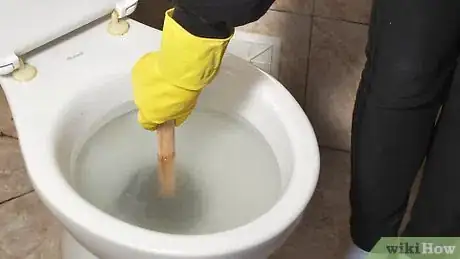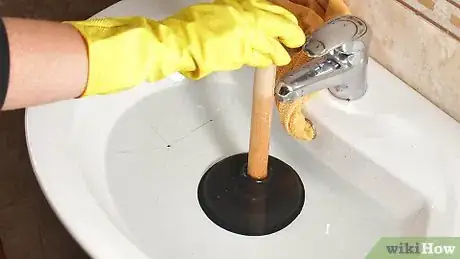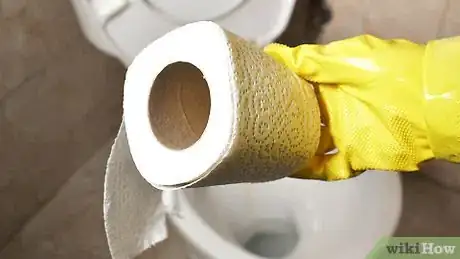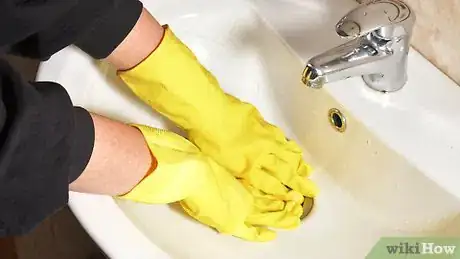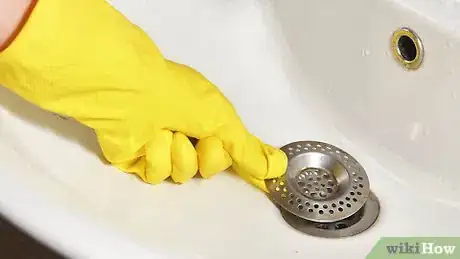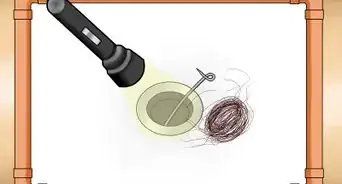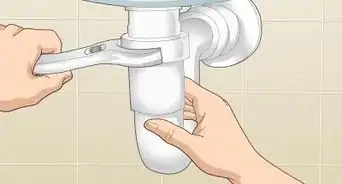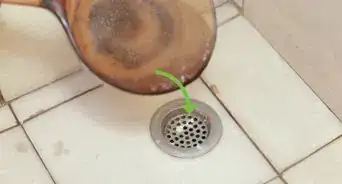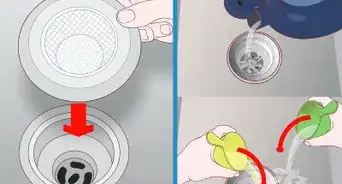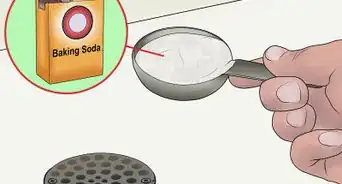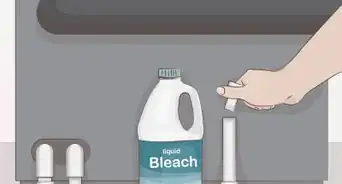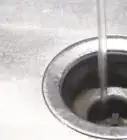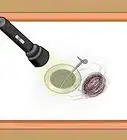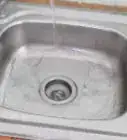This article was co-authored by James Schuelke and by wikiHow staff writer, Hannah Madden. James Schuelke, along with his twin brother David, is the co-owner of the Twin Home Experts, a licensed plumbing, leak detection, and mold inspection company based in Los Angeles, California. James has over 32 years of home service and business plumbing experience and has expanded the Twin Home Experts to Phoenix, Arizona and the Pacific Northwest.
There are 10 references cited in this article, which can be found at the bottom of the page.
This article has been viewed 162,469 times.
We’ve all been there: a toilet that won’t flush, a sink that won’t drain, or a shower filling up with water. Thankfully, using a plunger the right way can solve all of these problems and save you from an expensive plumbing bill. There are a few tricks and tips to keep in mind as you use your plunger to clear your clog quickly and without a huge mess.
Steps
Unclogging a Toilet
-
1Situate the rubber lip of the plunger around the hole in the toilet. The best plunger to use for a toilet is a flange plunger, which has an extended piece of rubber sticking out of the middle. Grab your plunger and press the rubber opening around the hole in your toilet to create an airtight seal.[1]
- Situating your plunger is the most important part! If you don’t create a seal, your plunger won’t be able to remove the blockage.
- If you have a normal or standard plunger, that’s fine too. You may have to put a little extra force into your plunging motion, though.
-
2Hold the plunger handle straight up, not at an angle. It might seem easier to hold your plunger at an angle, but this could break the airtight seal. Keep the wooden handle pointed straight up toward the ceiling as you situate your plunger.[2]
- This will keep the flange, or the long rubber center of the plunger, going straight down into the hole of the toilet.
Advertisement -
3Move the plunger handle up and down for about 20 seconds. Put both hands on the wooden handle and forcefully push the handle in, then bring it up again. Be careful not to break the airtight seal as you push back and forth. Keep doing this for 10 to 20 seconds to break up the clog in your toilet.[3]
- This is also called “burping” the plunger.
- Don’t be gentle as you plunge! The more force you put into it, the better the plunger will work.
- If you accidentally break the airtight seal, that’s okay. Just situate the plunger back over the hole in the toilet and start again.
-
4Lift the plunger up to drain the water in the bowl. After about 20 seconds, the plunger should have broken up the clog enough for the water to drain. Now you can flush your toilet to drain the bowl![4]
- If the plunger didn’t unclog the toilet, you can try it again. If your toilet is still clogged after a couple attempts, you can try using dish soap and hot water or baking soda and vinegar to break up a tough clog.
Unclogging Sinks and Showers
-
1Cover the drainage hole in a bathroom sink with a towel or rag. The drainage hole in your sink is usually just below the faucet or the rim of the sink itself. Use a rag or a towel to plug the drainage hole so no air can escape as you plunge.[5]
- If you don’t clog the drainage hole, the plunger won’t be effective since it can’t create an airtight seal.
- Bathroom sinks usually have drainage holes. Showers and kitchen sinks probably don’t.
-
2Scoop out any excess water. If your sink or shower is currently full of water, use a cup to pour some of it out to make plunging easier. If the water is brown or dirty, use gloves to protect your hands.[6]
- If you’re worried about water overflow, put a few towels or rags down around the sink or the tub.
-
3Situate the cup of the plunger over the drain. Grab a standard plunger (one without an extra flange on the end) and cover the drain with it. Hold the handle upright, not at an angle, to create an airtight seal.[7]
- Holding the plunger at an angle could break the seal, so it’s important to keep the wooden handle pointing straight up at the ceiling.
-
4Push and pull the plunger for 10 to 20 seconds. Grip the plunger firmly with both hands and use force to plunge it down, then up, then down again. Keep doing this for about 20 seconds to force the clog out of the drain.[8]
- Be careful not to lift the rubber part of the plunger off the drain, which will break the airtight seal. If you do, just situate it over the drain again and keep plunging.
-
5Lift the plunger up to let the water drain. After about 20 seconds, the drain should be free of any clogs. Take the plunger off the drain and watch the water disappear.[9]
- If you’ve used your plunger on a toilet before, make sure you disinfect your sink or shower with bleach once you’re done.
- If the drain is still clogged, you may need to use a snake to break up tough clogs.
Preventing Clogs
-
1Keep everything out of the toilet except waste and toilet paper. Even “flushable” wipes can clog the small drainage pipes that lead out of your toilet. You should never flush paper towels, feminine products, or baby wipes, as they can cause clogs.[10]
- Large amounts of toilet paper can also clog your toilet, so go easy on how much you use at one time.
-
2Clean out the sink and shower drains once a week. Every week, remove the stoppers from the drains and pull up any debris that’s caught on the stopper. Throw the debris in the garbage rather than washing it down the sink. For shower drains, pick hair and soap scum from the drain covers.[11]
- You can also pour boiling water down your drains every other week to flush them out and keep them clear of debris.
- Use a wet/dry vacuum hose on drains to suck out any hair or debris that may be stuck inside the drain.[12]
-
3Install mesh drain screens in your sink or shower. Mesh screens are a great way to trap food, hair, and other debris before it gets into your drains. You can install these in showers, tubs, and kitchen and bathroom sinks by simply placing them over the drain. When you notice food or debris, just scrape it off into the garbage.[13]
- Clean the screens every one to two days to keep water flowing properly down the drain.
- For the shower, use a plastic hair catcher.
Warnings
- If you’ve recently poured a drain-clearing chemical down your sink or toilet, don’t use a plunger. You could splash dangerous chemicals onto your skin or your eyes.[15]⧼thumbs_response⧽
Things You’ll Need
Toilet
- Gloves
- Flange plunger
Sinks and Showers
- Towel / rag
- Gloves
- Standard plunger
References
- ↑ https://www.bobvila.com/articles/how-to-plunge-a-toilet/
- ↑ James Schuelke. Professional Plumber. Expert Interview. 1 October 2019.
- ↑ https://www.youtube.com/watch?v=tEMdOD9mqa0&feature=youtu.be&t=117
- ↑ https://www.youtube.com/watch?v=WOD1sJcE5MY&feature=youtu.be&t=91
- ↑ https://www.bobvila.com/articles/how-to-use-a-plunger/
- ↑ https://www.bobvila.com/articles/how-to-use-a-plunger/
- ↑ https://www.youtube.com/watch?v=Ws79UoDddWI&feature=youtu.be&t=94
- ↑ https://www.thisoldhouse.com/plumbing/21164644/how-to-clear-any-clogged-drain
- ↑ https://www.thisoldhouse.com/plumbing/21164644/how-to-clear-any-clogged-drain
- ↑ https://jacpropertymanagement.com/wp-content/uploads/2017/09/how-to-prevent-clogged-toilets.pdf
- ↑ https://www.weny.com/story/41574629/how-to-prevent-clogged-drains-7-practical-tips
- ↑ James Schuelke. Professional Plumber. Expert Interview. 1 October 2019.
- ↑ https://www.weny.com/story/41574629/how-to-prevent-clogged-drains-7-practical-tips
- ↑ https://www.youtube.com/watch?v=tEMdOD9mqa0&feature=youtu.be&t=95
- ↑ https://www.bobvila.com/articles/how-to-use-a-plunger/
About This Article
To use a plunger, start by submerging it in the water-filled sink, tub, or toilet so it's covering the drain. Then, tilt the plunger to the side to release any air bubbles that are trapped underneath. Next, move the handle of the plunger up and down for about 20 seconds, which will push pressure in and out of the drain so it unclogs. After 20 seconds, lift the plunger out of the water and see if the water drains. If it doesn't, repeat the process. To learn how to prevent clogs, scroll down!
